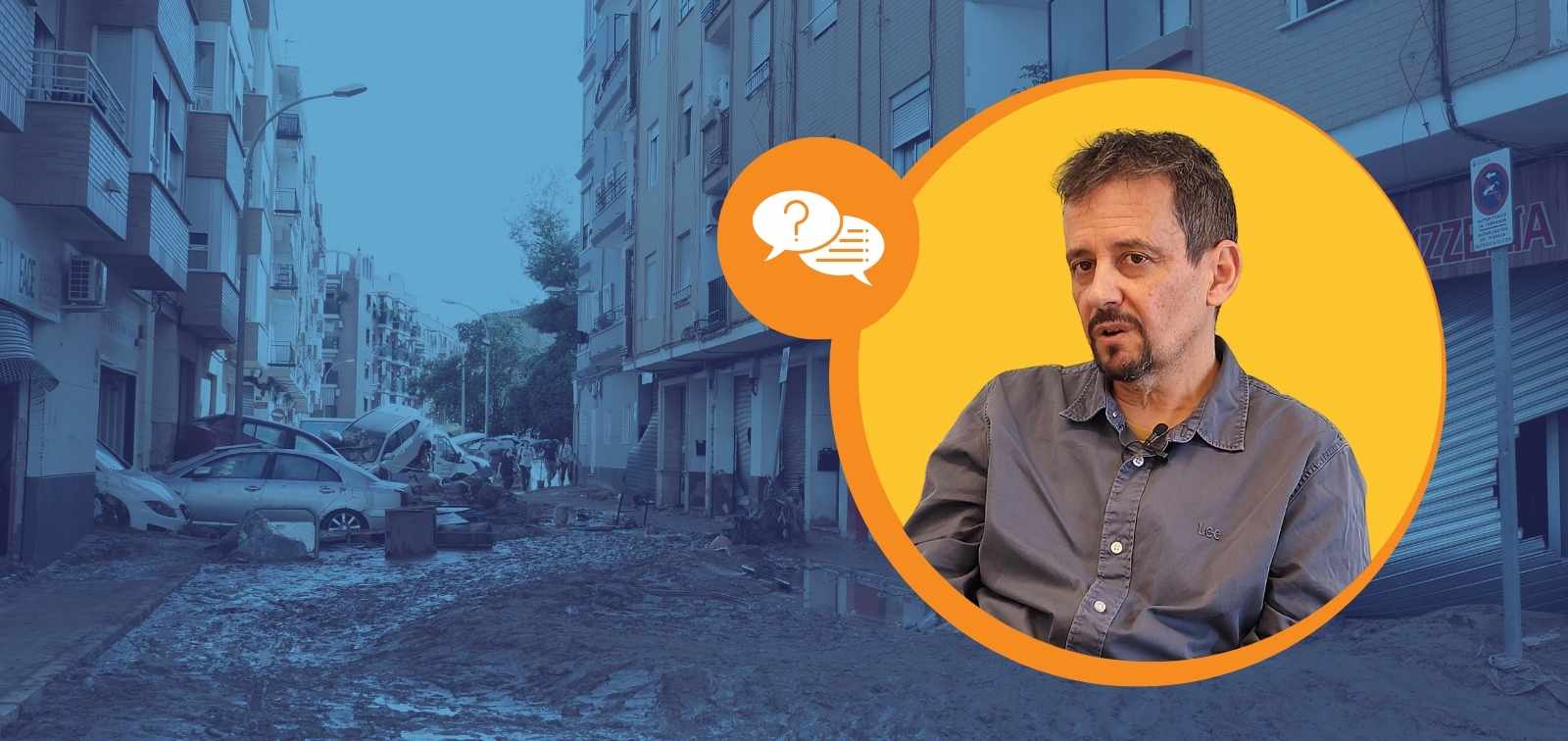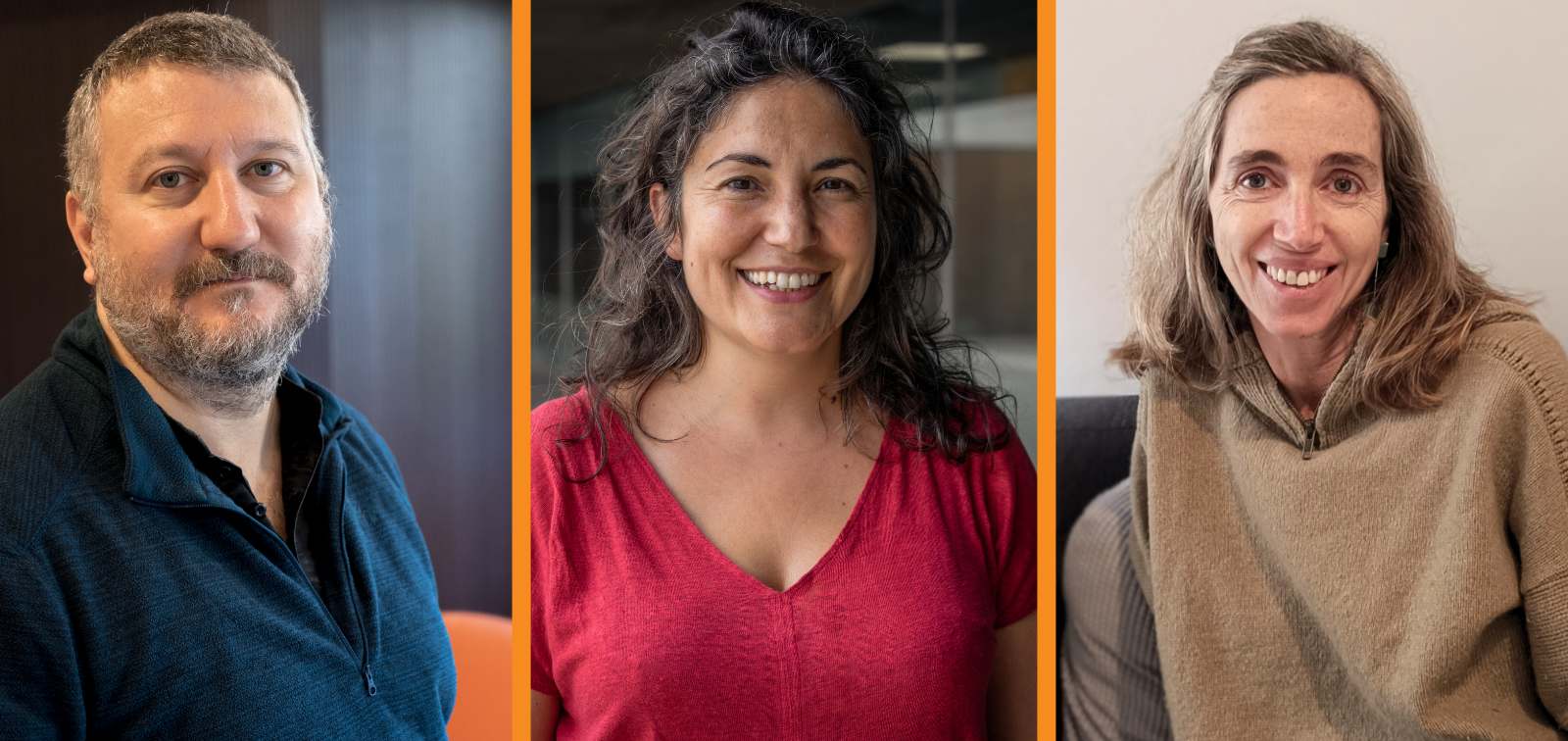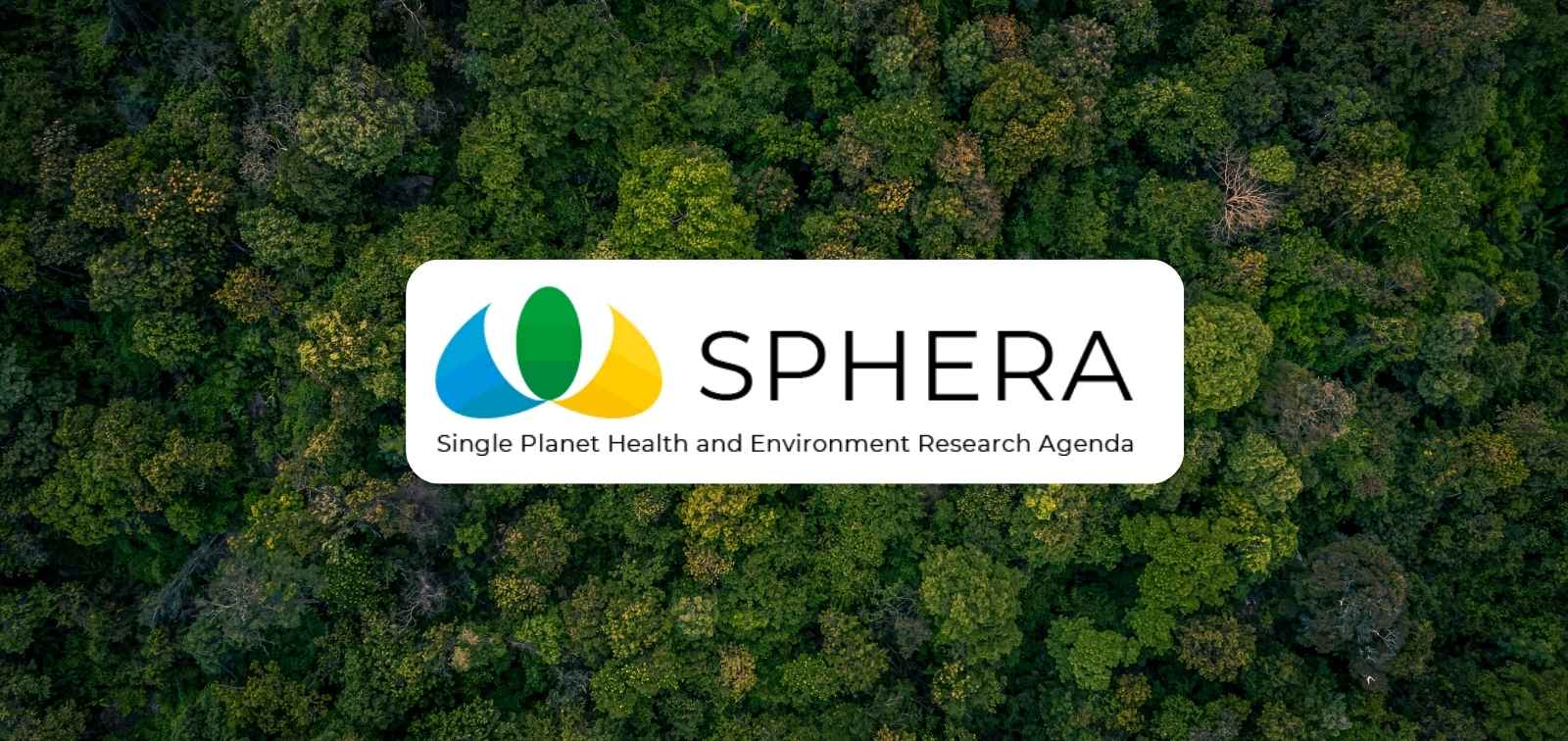Interview with Xavier Rodó: "The Iberian Peninsula Is Particularly Vulnerable to Climate Change. We Are Not Tuvalu, but We Are Halfway There"
Xavier Rodó, head of the Climate and Health Research Group at ISGlobal, talks about the flooding in Valencia, climate change and the future of the Mediterranean
21.11.2024
With people still missing and mud covering the villages affected by the October 29th floods in Valencia, we pause to reflect on what happened in the sky that fateful day, what lies ahead of us in this part of the Mediterranean and beyond due to global warming, and how science is advancing to provide us with the best tool for action: knowledge. We interviewed Xavier Rodó (Terrassa, 1965), ICREA Research Professor and Head of the Climate and Health Research Group at ISGlobal.
-As a climatologist, were you surprised by what happened in Valencia?
-It is difficult not to be surprised by such an event. You are surprised by the magnitude of its consequences, although relatively speaking, and it is hard to say, it is very small compared to, for example, tropical cyclone Nargis, which killed more than 100,000 people and destroyed entire communities in Myanmar in 2008, or the drought in the Horn of Africa in 2011, which claimed more than 250,000 lives, according to estimates by the World Weather Attribution (WWA) group. However, in what we might call the “first world”, it is an extreme and catastrophic event in terms of its consequences. In terms of the specific meteorological situation, although such events don’t occur often, they are not uncommon in this part of the western Mediterranean and has been well known for many years. What was initially unexpected was the energetic load associated with this particular event, which caused very heavy rainfall. However, the forecasts pointed in the right direction.
-So we will have more extreme events?
-Unfortunately, they will become more frequent. It is no longer science fiction, we must begin to understand that the predictions are coming true. From a social point of view it is a disaster, but from a scientific point of view it is a success. What is happening in the Mediterranean is going to get worse, because we have a very active cyclogenesis zone in the western part, which is going to get stronger as the sea continues to warm.
-Is the western Mediterranean considered a planetary hotspot?
-Yes. On the one hand, we see a progressive and steady increase in surface air temperatures and the warming of the Mediterranean Sea, accompanied by less rainfall during the two main rainy seasons, as a long-term trend. On the other hand, we are witnessing an intensification of extremes: the Spanish Levant region has a very active cyclogenesis zone, where autumn conditions lead to collisions between cold air masses and warm, moisture-laden air masses. These interactions fill the air column and, when released, trigger energetic discharges in the form of torrential rains. These heavy rains are expected to become more frequent. We could go from drought conditions to situations where it rains heavily but the reservoirs remain half empty. This reflects a dichotomy between decreasing water resources and increasing extreme weather events. We must begin to adapt to these increasingly variable and diminishing resources.
-What other factors are at play?
-Global warming, which raises air and water temperatures, also changes general atmospheric circulation patterns. For example, as in the case of an isolated high-altitude cold air mass, it can cause "bubbles," or masses of very cold air at high altitudes, to break away from the usual mid-latitude flow over Europe and move toward the Mediterranean. In addition, certain planetary-scale phenomena can amplify this process in certain years - for example, the strong El Niño that began last year and continued well into 2024. This phenomenon transfers a significant amount of energy through climate teleconnections to latitudes outside the tropics. It's like heating up a pressure cooker: the heat has to escape somehow. The excess energy finds regional outlets, many of which are well known, including the Mediterranean Sea, especially its western part. As a result, when a large amount of energy accumulates, it can lead to extreme rainfall events, such as the one in Valencia, where almost a year's worth of rain fell in just eight hours.
3 degrees of warming is a different world
-We already know that 2024 will be the hottest year on record and the first to exceed 1.5 degrees of warming above pre-industrial levels, the limit set by the Paris Agreement. How does this data make you feel?
-It's hard to say. As a scientist, there is a sense of satisfaction in seeing the work of so many years validated. But as a citizen, the disappointment is immense. Nevertheless, I believe that knowledge gives us tools for action, and that the generation of new scientific knowledge can somehow mobilize action in various fields. What worries me most is that at the current rate of emissions, we are heading for 2.7 to 3 degrees of warming by the end of the century. That would be a very different world.
-What will be the consequences if we reach 3 degrees of warming?
-The models may not be perfect - they are always approximate - but they clearly show that at 3 degrees of warming, the Atlantic thermohaline circulation would collapse. This is the system of ocean currents that circulates water in the Atlantic, moving warm water north and cold water south, and is crucial to maintaining Europe's temperate climate. Its collapse would trigger numerous cascading effects across the planet. Let's be clear: while we often talk about limiting warming to 1.5 degrees, the reality ahead is much more alarming. This naturally fuels pessimism, but I also want to change the narrative and focus on solutions.
-How can the message be turned around?
-From a scientific perspective, we are gaining an increasingly detailed understanding of how the planet and climate systems behave. While there have been surprises, particularly regarding the planet's high climate sensitivity as seen recently, this knowledge should strengthen our conviction as a society to pressure governments to change the system. We need to redefine our relationship with the environment. It's essential to move away from the historical mindset of humans as limitless resource extractors and understand that infinite growth is not possible. We've already reached planetary limits, and this requires a reorganization of the distribution of wealth. This doesn't mean going back to the way we lived 50 years ago - although in many ways life was better then - but rather managing our development based on the finite resources available rather than on unchecked demand. This change must occur at the local, regional, state, and national levels. It's time to change the way we organize ourselves as a society and ensure that intelligence and foresight are reflected in decision-making at the highest levels.
Summits to avoid decisions
-How do scientists in this field feel about the fact that climate change denial is gaining momentum?
-It is not a scientific problem; it is a sociological problem - a problem of human behavior. It goes beyond what we as scientists can directly address. A broad societal debate is needed to address this issue, and we are not the only ones who should decide how to proceed. Climate denial exists and will continue to exist, and it is gaining strength under the current global political conditions. It has become a widely used tool to justify inaction.
-Can COP29 do anything?
-Climate summits have become increasingly bureaucratic, making transformative decisions more difficult than ever. In fact, such decisions are simply not being made. It often feels like summits are designed to avoid making them. We've become too used to the ritual: late-night negotiations on the last day, as if the previous two or three weeks had been wasted on procedural formalities. ISGlobal is an accredited observer at COP29, and I see the same pattern emerging: endless debates over the wording of minor clauses in sub-paragraphs, while the most critical issues are completely sidelined. Enough is enough - we have already had 29 climate summits! This is a major problem. It's the same dynamic with biodiversity summits; we've had 16 of them now and little has changed. This is dangerous. We need to change the way we work - not only within the scientific community, but also with the general public. Most importantly, we need to put pressure on governments to act decisively.
-What are the issues that need to be addressed urgently?
-The COP has been dealing with the same issues for many years. One is the mechanism and the size of the Loss and Damage Fund—how to compensate the countries and regions that have been suffering the effects of climate change for years, and who is responsible for paying for it. On the other hand, there is no subsequent verification mechanism or agency to ensure that states comply with their commitments and pay this debt (which, in fact, we must consider as a debt already incurred by developed countries and both historical and current emitters). In the end, everything will be purely voluntary, and we will get nowhere.
-What can we do about this lack of action by the summits?
-We need to create a new mechanism that forces countries to compensate for the effects of their historical actions, which are already well-documented. What we need is both the political will and a new framework, because it is clear that the theory of the "common good" does not work for this type of global issue. But this seems difficult, as we can see that UN decisions are very weak in other areas, such as armed conflicts, where resolutions often go unenforced. So, how can we expect the resolutions of a subordinate organization, which depends on the UN, to be respected? In any case, despite the risk of sounding pessimistic, I always end up believing that the power of the people, which is starting to shift in many countries due to climate disasters, will eventually change the way many governments act.
We are not Tuvalu, but we are halfway there.
-Is there anything we can do at the individual level, or should we focus on demanding action from governments?
-You can help reduce your environmental impact, for example, by following the "three Rs" (reduce, reuse, and recycle). However, it must also be said that the aware citizen has been overly blamed, while large corporations and multinational companies have been insufficiently held accountable. The major oil lobbies and business groups coined the term "carbon footprint" to put the spotlight on individuals, and this term has been used ad nauseam, even by left-wing politicians. As citizens, we should follow the guidance of experts on what to do, but the solution to a problem of this magnitude goes far beyond individual actions, and in some cases, beyond what the state can address alone. The Spanish state, in particular, is starting to suffer more than other countries because we are warming much faster than the rest of Europe, and because mitigation and adaptation policies and plans have been entirely inadequate so far. We're not Tuvalu, but we're halfway there, and the solution needs to come not only from our state, but also from international agreements. On a global scale, however, one might argue that it’s not entirely bad that the effects of climate change are now reaching wealthy countries, because this could spur action.
-Do politicians and administrations consult you on these issues?
-In Catalonia and Spain, we still operate in an outdated manner, and I'm sorry to say it, but we need to speak out. Here, if a politician knows someone or has been told that a person is an expert, they pick up the phone and get an expert opinion right away. We should aim to work much more objectively, as is done in countries with a long tradition of climate research, which are much more advanced than we are—by using the best available information at any given time. We have excellent researchers and research groups that are underutilized by our political class. Politicians, and especially the public, deserve to have the best possible information, even if they have to seek it from outside the country, because, unfortunately, not enough has been invested in this field of knowledge here.
Intensity and forgetfulness
-Will anything change after what happened in Valencia? Can it be a turning point?
-I would like to say yes, but if I had to bet, I would definitely say no. All we have to do is look at the example of the COVID-19 pandemic, where, in theory, we were all supposed to learn a lot, but the truth is that very little has changed since then. For starters, we still do not have a national epidemiological agency or a pandemic forecasting system that fully utilizes the available tools, because the political class neither understands nor believes in them. If we were to face that situation again, we would encounter the same problems and shortcomings. An event like the floods in Valencia, like all extreme phenomena, has an intense psychological impact in the first few weeks or months, but then it is forgotten. In this sense, I would say that there will be no changes. On a broader level, beyond politicians, there is no perception of the magnitude or seriousness of these events, and unfortunately, we are learning this the hard way, through the experiences and suffering of many people.
Drawing the line
-Are we at a point of no return or can we still slow down climate change?
-From a scientific point of view, we have a better understanding of how the planet behaves. However, this also leads us to see that, throughout many crucial moments in Earth's history, climate has played a fundamental role. In a positive sense, because we know that 600,000 years ago, climate was the trigger for the emergence of multicellular life, thanks to the end of the Snowball Earth period, when the planet was no longer frozen, and also because of the climatic role during a major episode of global oxygenation. But also in a negative sense, less than 250,000 years ago, during the Permian-Triassic transition, we know that the magnitude and frequency of El Niño events in the tropical Pacific were so extreme that they led to a major extinction of species and a massive loss of terrestrial and marine biodiversity. And this occurred under conditions of CO₂ emissions ranging from 410 ppm to 860 ppm. Warning! These values are already included in the climate change scenarios projected for the coming decades! This should give us pause for thought.
-How can science help us?
-We are now able to design "safe" climate scenarios, where certain planetary variables must not be exceeded. These are called safe pathways. In other words, we are anticipating what politicians might ask us to do in the coming years, and there is a significant international research effort in this direction. What are the planetary emissions limits? If we stop emitting, will the planet return to previous conditions, or will there be hysteresis (the transition of the climate to a new state of equilibrium, driven by a forcing that causes an irreversible chang), leading to a different world, depending on where we are? What are the deforestation limits in certain parts of the world to prevent the collapse of biodiversity or the transition from forests to savannas? Is the sequestration of greenhouse gases possible as a planetary solution? What should we avoid doing or going beyond? We are generating immense knowledge that we didn't have before. Ten or twenty years ago, it would have been impossible to argue that this could be done - and now we are doing it. We can simulate a parallel planet and manipulate it to better understand how it behaves. So even if we as a society are in a boat approaching a waterfall, we now know exactly how much time we have to get out of the boat or what we need to do to steer it to safety. All we have to do is decide to take action.
Interview by Yvette Moya-Angeler.



















